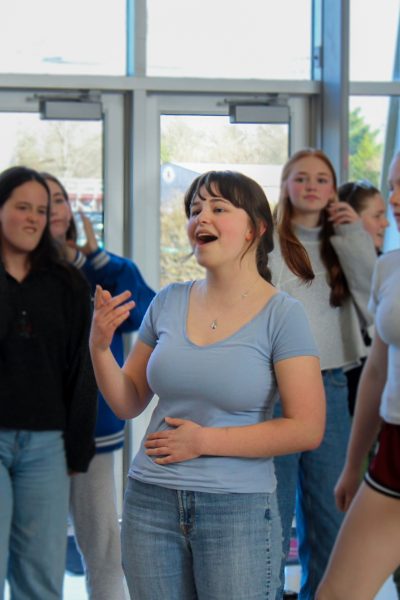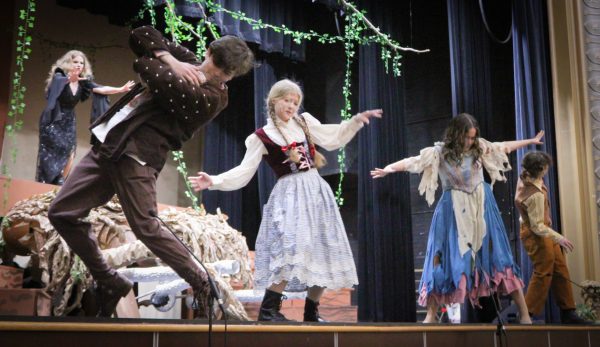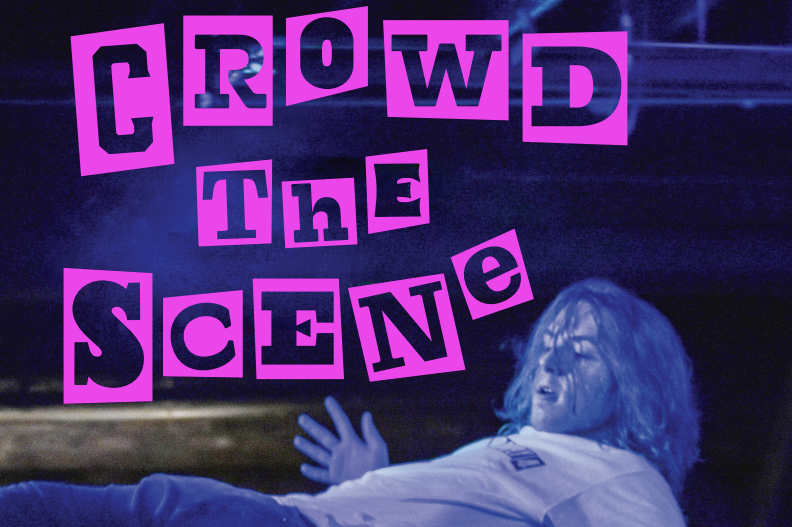Chills. As I stood up and applauded the cast of Sacred Heart Academy’s rendition of “Into the Woods,” goosebumps coated my body. The design and production made me feel like I, too, was in a mythical fairytale land, surrounded by lush greenery and the chirps of imaginary birds.
The makeup and costumes were so delicately executed, revealed by the tedious work of the light and sound crew.
Then there were the magnificent actors. Their passion was displayed so perfectly, so effectively, I often found myself clinging to the edge of my seat, awaiting their next line. Even when the performers weren’t speaking, they kept their focus on the person in the spotlight, incorporating facial expressions that showed genuine interest in the illuminated subject.
Each goosebump that prickled my skin represented something different about the musical; so much work, joy and passion went into just an hour and a half of entertainment.
Walking out of the auditorium, I couldn’t help but think about how easily such beauty could be taken for granted, or worse, lost entirely. As magical as that performance was, it stood in stark contrast to the harsh reality that many arts programs across the country face. While students and educators pour their hearts into these productions, strenuous circumstances hinder their work.
During financial slumps and global crises, Louisville’s art scene has been heavily impacted, but the arts have always persevered in times of conflict.
In the aftermath of the 2008 financial crisis, Louisville, like many cities, faced significant budget shortfalls which targeted many departments — including the arts. With a $29 million disparity in the city budget, former Mayor Jerry Abramson cut contributions to 26 arts groups, leaving them with half of the originally intended funds.
Many organizations went into survival mode. The Louisville Orchestra pulled through, indicative by their reorganization of the establishment, including a new artistic and executive director. But, adapting to a post-recession society that was timid to purchase new entertainment and non-necessary items would take time.
Then came the pandemic.
COVID-19 forced local theater organizations to cancel live shows and adjust to virtual performances, taking a large toll on the community.
For Actors Theatre of Louisville, this led to a steep drop in revenue — over $2 million. However, they didn’t let this hold them back.
“Over the course of this past year, Actors Theatre has built an entire library of digital work available to stream, as well as offering live, online experiences designed to create connection and community,” a 2021 Actors Theatre impact report read. “In a time of pandemic-induced isolation and upheaval for so many, it’s been important to us to continue finding ways to build critical consciousness and community, while also bringing some joy.”
Despite these efforts, many organizations like Actors Theatre have found it difficult to maintain or regain their pre-pandemic income and engagement, constantly fighting to stay open and continue providing a space for kids who wish to participate in theater.
On June 1, 2024, StageOne Family Theatre and Commonwealth Theatre Center (CTC) underwent a merger to combat similar struggles. The two groups rebranded to StageOne Family Theatre and renamed CTC as Walden Conservatory. This move showcased StageOne’s commitment to providing lessons, shows and skills to the arts-inclined youth of Louisville.
Andrew Harris, StageOne’s producing artistic director, claimed that a drop in student engagement leading up to the merger was primarily due to a lack of funding for arts education, as well as the 2023 JCPS transportation cuts.

The struggles of arts organizations from the 2008 recession to the more recent impacts of COVID-19 underscore that, without consistent funding, many arts programs are left vulnerable.
Blame can’t be squarely put on the local government’s lack of funding when the solution lies right in front of us — literally in our wallets.
It’s time for all of us to invest in the arts. Attend a local theater performance. Buy tickets for art galleries. Watch youth performers flourish on stage. When art begins to fade, it is the responsibility of the public to revitalize it.
Behind the Curtain
The level of dedication required for student theater is often underestimated. The participants, however, are keenly aware of the immense effort that goes behind each show.
“It definitely needs more recognition than it receives,” Elyse Wilcox, 17, a junior at Ballard High School, said.
Wilcox has been a member Louisville’s theater community since elementary school and most recently performed in the ensemble of Ballard’s “Shrek the Musical.”
“A lot of people that work in art and theater industries do so much and pour so much into what they do,” Wilcox said.
Alongside the need for greater recognition, she pointed to limited financial support as another major challenge.
“I think lack of funding is probably the biggest issue,” Wilcox said. “We do try to do a lot of fundraisers, but honestly, a lot of times they don’t raise very much money, especially specifically theater fundraisers. I feel like people don’t donate as much to theater as they would for other causes.”
Caylen Judd, 18, was Cinderella in Sacred Heart Academy’s “Into the Woods” and also believes that the community has more to give to the arts.
“I think we need to treat arts education as essential, not extra. I have always felt this way, whether it’s in the school systems or just the community as a whole,” Judd stated in a text. “I think everyone can appreciate the arts no matter what.”
Judd explained that she has seen more funding and recognition go to science, technology, engineering and mathematics (STEM) projects in JCPS and in Louisville.
“I think STEM is prioritized more because typically STEM careers are more high paying and ‘practical’ to make a living,” Judd said. “I disagree with that theory because I think that being involved in art programs is the best way to become a leader.”
This cultural comparison from STEM to the arts reflects a broader idea that has been gaining traction over the years. In many cases, STEM provides monetary success — an almost certain guarantee that anyone who learns STEM skills will be more financially successful than other fields of study.
Kathie Davis is working to change this narrative.
From STEM to STEAM
Davis, the executive director of Sacred Heart’s Academy of the Arts, believes the solution lies in adding another letter to the acronym: what once was STEM will now be STEAM.
“There’s a place for STEM,” Davis said. “But the A in STEAM is that arts component that gives you that authenticity, that gives you that ability to sell, that gives you that ability to get up in front of people and that warmth I just feel like may be missing if you’re only looking at STEM.”
Davis has been involved in the theater environment for quite some time. She helped start a theater focused section of the Oldham County Schools Arts Center in 2008 before finding a job at Sacred Heart Academy three years ago.
Davis thinks the best way to merge the strengths of these fields and ensure continued support is to simply adjust the framework of the discussion.
“The problem is you have lots of technical skills. People can come in and they can write code all day long and they can do it, but if they can’t hold a room, they can’t make the sale,” Davis said. “If I can’t make that presentation, I don’t have investors and then we don’t have a business, and I think theater does that.”
Blending both art and STEM combines the qualities needed to navigate the pressures of real-world situations. The indispensable skill of handling conversations and displaying one’s best self is something that theater inherently requires.
When students engage in theater, they are constantly honing their ability to think on their feet, collaborate with others and communicate effectively — all vital traits for traversing complex environments in any career.
“There’s so many day-to-day skills that you get in theater,” Crystian Wiltshire, the community engagement manager at StageOne, said. “There’s so many wonderful gifts that this thing of ours can give that go far beyond pursuing this professionally.”
Almost a year since the merger, StageOne and CTC are still working to keep this community alive. While they originally underwent the shift to address financial issues caused by decreased ticket sales post-pandemic, StageOne still had trouble reaching their most critical audience: the youth.
“Now that the merger is complete, how can we continue to tell our story?” Wiltshire asked.
This question led them to a more creative solution — one that strays from the norm in the performing arts: instead of struggling to bring schools to the performance, StageOne could find a way to bring the performance to them.
“We’re able to say, ‘Hey, StageOne can actually come out to you,’” Wiltshire said. “We saw some really wonderful results from that.”

In the fall of 2024, a handful of StageOne performers traveled out in vans to schools across the county, cutting down the cost and stress of busing students to and from an experience. This shift in approach allows them to continue providing for students who might otherwise have to miss out, ensuring that the arts remain accessible.
“That is a wonderful pipeline to be able to say that some Walden kid eventually continued on in pursuit of theater,” Wiltshire said. “That’s a beautiful thing. What’s also wonderful and just as beautiful is someone that is enrolled here, or maybe just saw a StageOne show, and decided to become a lover of theater as an audience member.”
By meeting schools where they are, StageOne aims to maintain its connection with young audiences and continue fostering creativity in the classroom.
“Being here in the conservatory and seeing these kids, this is such a safe haven for them,” Wiltshire said. “All of the work that we do on the administrative side, they all need us to be doing that work to keep this machine going.”
…
As I’ve come to finish this article, I have realized that journalism is also art. It provides insight into the human experience, a way for not only the audience, but the author, too, to understand the world around them.
Think of the music you listen to on a car ride home, the clothes on your body or the decorations that encapsulate your room. That is art.
Every time art creates an emotion, whatever the medium, the artist has done their job.
When a political cartoon makes you mad, when a movie makes you cry, when the first few notes of a nostalgic song stirs up melancholy, when a theater performance gives you chills — so many emotions are tied to and caused by art.
There’s something so beautiful about the power of art, as it’s driven by the need to communicate — to take the raw materials of life and craft them into something that resonates with people.
Supporting local theater doesn’t always require a ticket purchase. It can also mean spreading the word, volunteering your time or encouraging the people around you to engage in these vital cultural experiences we take for granted.
Remember that feeling when the performance transported you, when the final note of the show sent a ripple of chills down your spine or when the passion of the performers pulled you into their world. That moment — the goosebumps, the awe, the connection — is something that can be replicated by theater for everyone. It’s a magic that taps into the deepest parts of our emotions, challenges our perspectives and celebrates the complexities of the human experience.
Theater is an art form that doesn’t just entertain — it has the power to make us feel, to make us think and to unite us in a shared space of creativity.
We all have a role to play. Investing in the next generation solidifies theater as an adapting medium that gives young performers not only their passion, but the tools to prepare themselves for that next step.












